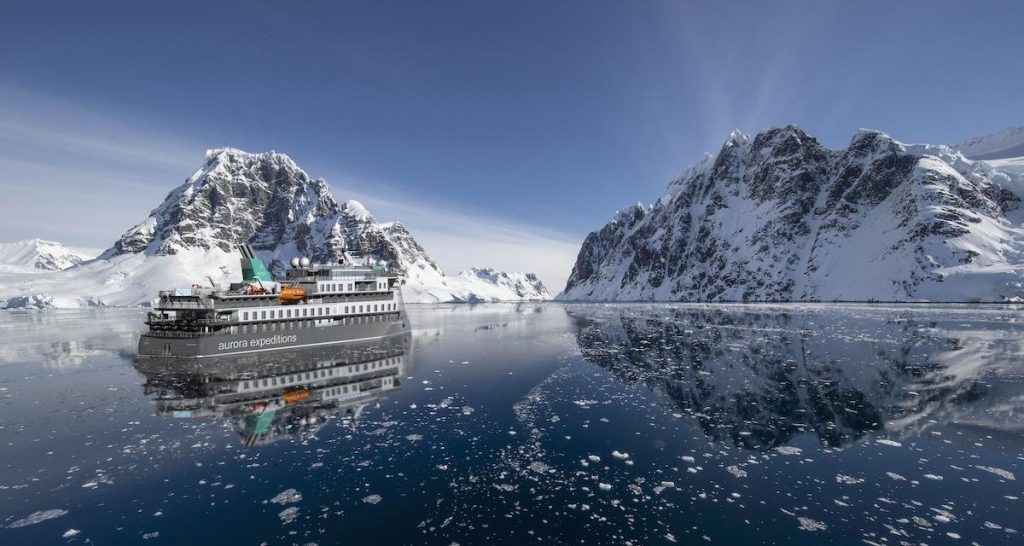Aurora Expeditions, a small Sydney-based cruise line, is on a mission to rewrite the cruise industry’s sustainability narrative in a big way.
With a focus on expedition cruises to the Arctic and Antarctic, the company is making bold claims about its environmental efforts, including becoming the first cruise line to get B Corporation bragging rights.
But can Aurora truly deliver on its promises? And, in an industry notorious for pollution and waste, does sustainability even matter?
Reality check: The cruise industry has long been criticized for its reckless environmental practices. For example, cruise ships in Europe emit as much sulfur dioxide as one billion cars, according to a recent study. From carbon emissions to waste disposal, the cruise industry’s overall environmental record is downright awful.
Against this backdrop, Aurora’s claims of sustainability seem almost too good to be true.
“Sustainability is who we are”
Sasha Buch, Aurora’s sustainability manager, met me at the company’s headquarters in the Surry Hills neighborhood of Sydney, a quiet district filled with apartments, office buildings and cafes. One of the first things she told me was that Aurora is a different kind of cruise line.
“Sustainability is who we are,” she says, pointing to the company’s founding in 1991 by mountaineer Greg Mortimer and his wife, Margaret, both passionate environmentalists.
The B Corporation certification, which Aurora achieved last year, is a designation that requires companies to meet rigorous standards for social and environmental performance, accountability, and transparency. Becoming a B Corp is a journey, not a destination; standards are revised annually, keeping ever B Corp on its toes.
A closer look at Aurora’s sustainability initiatives
Aurora’s actual sustainability efforts are wide-ranging. Here’s a breakdown of their key initiatives:
Aurora’s fleet includes three state-of-the-art ships designed with sustainability in mind. Features like the X-BOW design, which reduces fuel consumption, and shore-based power systems promise to reduce the environmental impact of cruising.
“Our ships are a testament to what’s possible when you prioritize sustainability,” Buch says.
Aurora achieved a carbon-neutral certification in 2021, meaning it measures and offsets its carbon emissions. The company has also partnered with Trace, a green technology company, to map a path to net-zero emissions.
“We’re not just offsetting,” Buch told me. “We’re actively reducing our emissions.”
Aurora’s Citizen Science Program allows passengers to participate in data collection, from photographing whales to testing for microplastics. Buch says the educational initiatives deepen their passengers’ understanding of the environment and, over time, will support a more sustainable cruising experience.
The cruise line adheres to strict international standards for waste and water management, eliminating single-use plastics and using eco-certified cleaning products.
Aurora’s Community Ambassador Program works with Inuit communities in the Arctic to promote cultural exchange and provide economic benefits to indigenous communities.
Aurora’s newest ship, the Douglas Mawson, also represents a leap forward. It will set the bar for conservation in the Antarctic when it launches in December. Programs such as waste minimization, carbon offset, and collaboration with leading conservation organizations will be built into the cruise experience. Aurora says the ship is designed to minimize environmental impact and will help travelers tread lightly on the fragile polar environment.
The big picture: Does sustainability matter?
The very nature of cruising — of transporting large numbers of people to remote and fragile ecosystems — is inherently destructive. And in this business, the most popular cruise lines are often the ones who can do it at the lowest price, not the most responsibly.
Aurora seems to know that the deck is stacked against a company that puts sustainability rather than profitability in the captain’s chair. And there’s a sense you get in talking to someone like Buch that it actually likes that kind of challenge.
“We’re always trying to do more because there’s always so much more that can be done,” she says.
Buch emphasizes the importance of transparency and accountability in Aurora’s sustainability efforts. The company is constantly making course corrections as it aims to become carbon-negative. She says the goal isn’t just recycling, but regenerative tourism — going beyond minimizing harm to actively restoring and improving the environments they visit.
“It’s about taking care of what we have now for future generations as well as repairing any damage that has been done,” she explains.
The company has a checklist of accomplishments, outlined in its latest impact report. It includes becoming carbon-neutral, participating in the cleanups to remove marine debris from the coastlines of Iceland and Svalbard, and demonstrating a “dramatic” reduction of single-use plastics in its operations.
The challenges ahead
Despite Aurora’s efforts, the fundamental question remains: Can an industry built on fossil fuels and mass tourism ever truly be sustainable?
Buch is optimistic.
“We have a responsibility to inspire, educate, and advocate for the protection and preservation of the places we visit,” she says.
Aurora is making giant strides in sustainability, and its B Corporation certification is a significant achievement. But the company’s efforts represent only one step in the cruise industry’s journey toward becoming green. And it won’t happen unless passengers want it to, which means they’re booking more cruises with a company like Aurora.
“We know there’s a long way to go,” she says.
Aurora’s journey toward sustainability is a work in progress — one that will require ongoing accountability and scrutiny. In the meantime, the takeaway is clear for travelers: You have to carefully consider the effect of your next cruise on the environment. It may be worth spending a little extra to go with a company that is dedicated to long-term sustainability.

